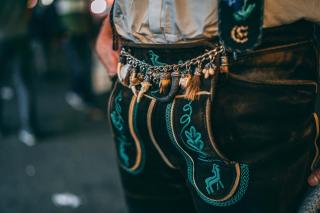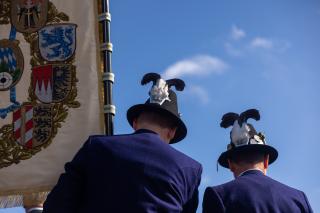Charivari: The most rustic costume accessory on the Wiesn outfit
The charivari is a very special Wiesn accessory with history and meaning. In the past, just about anything was attached to this solid silver jewellery chain: Money coins, precious stones, badger beards, animal paws and even teeth. Traditional values are still incorporated into the charivari today, even though it now comes in a modern design.

The Charivari: History and meaning
Today, the charivari is mostly seen in the hunting area "Oktoberfest". Men use it to refine their lederhosen look. In the past, the Charivari served as a talisman and was supposed to ensure a successful hunt for real hunters. It was also an important symbol of status for wealthy farmers and lords of the manor. Originally, the Charivari was a watch chain that was attached to the buttonhole of the traditional waistcoat and was often decorated with various trophies. Interesting fact: it could not be bought, but was passed down from generation to generation. If you want to wear a Charivari today, you usually have no choice but to buy one - you can do this in traditional costume shops or at the Auer Dult.
The word Charivari comes from the French and entered the German-speaking regions during the Napoleonic era. Translated into German, it means something like "noise", "cat music" or "racket".
Men's-Charivari: 33 centimetres - the optimal length
The Charivari for men has an ideal length of 33 centimetres. The new variants are usually made of 925 sterling silver; in the past, the accessories were often made of 800 silver. Even today, small parts of shot animals are incorporated into the Charivari. Antler parts and raptor claws are just as popular as fangs. The Charivari is worn correctly over the "trouser door" of the Lederhose.
Women's-Charivaris — the new charm bracelets
Walking around the Wiesn today, you no longer discover the Charivari merely as an embellishment for your lederhosen. It has also become a popular accessory for the Dirndl . The ladies' version is more filigree than the Charivari for men, but is also decorated with small pendants and silver talismans (berlocks). This makes it look quite similar to the trendy "charm bracelet". The Trachten lady wears her Charivari either on the Dirndl bodice or on the waistband of the Dirndl apron. The first glance at a Charivari often gives the impression that the stringing together of the pendants is pure coincidence. But this is not the case. There is order in the supposed jumble of the many lucky charms. Each pendant has its own place and, of course, its own meaning.
Charivaris: Also an eye-catcher aside from the Wiesn
While the gentlemen of creation really only have the Wiesn and the one or other folk festival to adorn themselves with the Charivari, the ladies have completely different options. After all, the Charivari is now suitable for everyday wear. More and more women are not only wearing the traditional necklace with their Dirndl, but are also embellishing their everyday looks with it. (Bavarian) fashionistas, for example, like to combine casual clothes such as jeans and a shirt or blouse with a traditional cardigan, a Janker and the Charivari.


